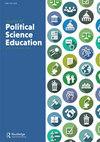给它旧的学院尝试:学术部门和政治学本科课程的变化,2009-2019
IF 0.6
Q3 POLITICAL SCIENCE
引用次数: 0
摘要
本文章由计算机程序翻译,如有差异,请以英文原文为准。
Giving It the Old College Try: Academic Departments and Undergraduate Curriculum Change in Political Science, 2009–2019
Abstract Thirty years after the last APSA-sponsored recommendations on the structure of the undergraduate political science major, new efforts at curriculum reform are under way. As a prelude to how the profession might respond, this article examines how political science departments made undergraduate curriculum changes during the 2010s. Based on a survey of department chairs in 2019–2020 (prior to the onset of the COVID-19 pandemic in the U.S.), one-half of political science programs changed major requirements in the previous five years and 70% made revisions during the decade. Most changes involved adding courses or tracks and modifying course sequences within the prevailing model of subfield distribution. Assuming departments are rational actors seeking to improve student learning and respond effectively to the educational marketplace, various explanations of curriculum change were tested. Structural variables (institutional type and departmental factors) had no significant effects. Nevertheless, the survey revealed learning-based (acquiring disciplinary knowledge, developing intellectual skills) and market-based (concern about enrollments) motivations for change, as well as institutional constraints. Among curricular alternatives to the distribution model, evidence indicated greater support for promoting liberal learning outcomes. Moreover, the civic engagement movement influenced departmental decision-making. However, few programs made curriculum changes related to diversity, equity, or social justice, notable concerns among students and within the discipline.
求助全文
通过发布文献求助,成功后即可免费获取论文全文。
去求助
来源期刊

Journal of Political Science Education
POLITICAL SCIENCE-
CiteScore
1.80
自引率
36.40%
发文量
69
期刊介绍:
The Journal of Political Science Education is an intellectually rigorous, path-breaking, agenda-setting journal that publishes the highest quality scholarship on teaching and pedagogical issues in political science. The journal aims to represent the full range of questions, issues and approaches regarding political science education, including teaching-related issues, methods and techniques, learning/teaching activities and devices, educational assessment in political science, graduate education, and curriculum development. In particular, the journal''s Editors welcome studies that reflect the scholarship of teaching and learning, or works that would be informative and/or of practical use to the readers of the Journal of Political Science Education , and address topics in an empirical way, making use of the techniques that political scientists use in their own substantive research.
 求助内容:
求助内容: 应助结果提醒方式:
应助结果提醒方式:


